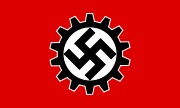
German Labour Front
Encyclopedia


Nazism
Nazism, the common short form name of National Socialism was the ideology and practice of the Nazi Party and of Nazi Germany...
trade union
Trade union
A trade union, trades union or labor union is an organization of workers that have banded together to achieve common goals such as better working conditions. The trade union, through its leadership, bargains with the employer on behalf of union members and negotiates labour contracts with...
organisation which replaced the various trade union
Trade union
A trade union, trades union or labor union is an organization of workers that have banded together to achieve common goals such as better working conditions. The trade union, through its leadership, bargains with the employer on behalf of union members and negotiates labour contracts with...
s of the Weimar Republic
Weimar Republic
The Weimar Republic is the name given by historians to the parliamentary republic established in 1919 in Germany to replace the imperial form of government...
after Adolf Hitler's
Adolf Hitler
Adolf Hitler was an Austrian-born German politician and the leader of the National Socialist German Workers Party , commonly referred to as the Nazi Party). He was Chancellor of Germany from 1933 to 1945, and head of state from 1934 to 1945...
rise to power
Machtergreifung
Machtergreifung is a German word meaning "seizure of power". It is normally used specifically to refer to the Nazi takeover of power in the democratic Weimar Republic on 30 January 1933, the day Hitler was sworn in as Chancellor of Germany, turning it into the Nazi German dictatorship.-Term:The...
.
Its leader was Robert Ley
Robert Ley
Robert Ley was a Nazi politician and head of the German Labour Front from 1933 to 1945. He committed suicide while awaiting trial for war crimes.- Early life :...
, who stated its aim as 'to create a true social and productive community' (Smelster, 1988). Theoretically, the DAF existed to act as a medium through which workers and owners could mutually represent their interests. Wages were set by the 12 DAF trustees. The employees were given relatively high set wages, security of work, dismissal was increasingly made difficult, social security programmes were started by the Arbeitsfront, leisure programmes were started, canteens, pauses and regular working times were established, and therefore generally the German workers were satisfied by what the DAF gave them in repaying for their absolute loyalty.
Employment contracts created under the Weimar Republic
Weimar Republic
The Weimar Republic is the name given by historians to the parliamentary republic established in 1919 in Germany to replace the imperial form of government...
were abolished and renewed under new circumstances in the DAF. Employers could demand more of their workers, while at the same time workers were given increased security of work and increasingly enrolled into social security programmes for workers. The organisation, by its own definition, combated capitalism, liberalism, but also revolution against the factory owners and the national socialist state. The DAF however did openly prefer to have large companies nationalised by the German state, instead of privately owned companies.
DAF membership was theoretically voluntary, but any workers in any area of German commerce or industry would have found it hard to get a job without being a member. Membership required a fee within the range of 15 pfennig
Pfennig
The Pfennig , plural Pfennige, is an old German coin or note, which existed from the 9th century until the introduction of the euro in 2002....
to 3 Reichsmark
German reichsmark
The Reichsmark was the currency in Germany from 1924 until June 20, 1948. The Reichsmark was subdivided into 100 Reichspfennig.-History:...
, depending on the category a member fell into in a large scale of 20 membership groups. A substantially large amount of income was raised through fees. In 1934, the total intake was 300,000,000 Reichsmark.
There were 2 main components of the DAF:
- Nationalsozialistische BetriebszellenorganisationNationalsozialistische BetriebszellenorganisationThe Nationalsozialistische Betriebszellenorganisation was a workers organization in Nazi Germany....
(NSBO; National Socialist Factory Organization) - Nationalsozialistische Handels- und Gewerbeorganisation (NSHAGO; National Socialist Trade and Industry Organization)
Several other sub-organisations were set up:
- Kraft durch FreudeKraft durch FreudeKraft durch Freude was a large state-controlled leisure organization in Nazi Germany. It was a part of the German Labour Front , the national German labour organization at that time...
(KdF; Strength through Joy) – Organisation giving the workers cheap/free holidays in addition to subsidised sporting and leisure facilities. - Schönheit der Arbeit (SdA; Beauty of Work) – Aimed to make workplaces more enticing to workers (e.g. renovations of outdated factories, new canteens for workers, smoking-free rooms, cleaner working spaces etc.).
- ReichsarbeitsdienstReichsarbeitsdienstThe Reichsarbeitsdienst was an institution established by Nazi Germany as an agency to reduce unemployment, similar to the relief programs in other countries. During the Second World War it was an auxiliary formation which provided support for the Wehrmacht.The RAD was formed during July 1934 as...
(RAD; Reich Labour Service) – Solution to the unemployment crisis the Nazis inherited. Provided cheap labour for big state projects, such as the Autobahns. Made compulsory for unemployed men 16-25 in 1935. Provided work security to many unemployed.
The Front also organised the Reichsberufswettkampf
Reichsberufswettkampf
The Reichsberufswettkampf was an annual vocational competition held in Nazi Germany as part of the Gleichschaltung of German society.The competition was organised by the German Labour Front with the aid of the Hitler Youth and the National Socialist German Students' League...
, a national vocational competition.
External links
- DAF @ feldgrau.com
- DAF information for AS Level History Unit 3
- Information on the RAD
- Deutsche Arbeitsfront (DAF) at Lebendiges Museum Online. In German.

